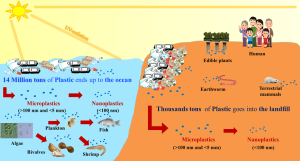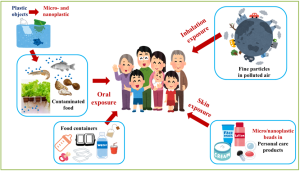Nano-plastics, Potential Impacts from Tiny Particles
博士研究員 Pham Thuy Linh
Hi everyone, I’m Pham Thuy Linh (ファム テユイ リン) from Vietnam. Currently, I work as a postdoc at the Laboratory of Physiology, Institute of Health and Sport Sciences & Medicine. My PhD project relates to the effects of hormones and environmental pollutants on autonomic nervous system regulation. Let me share one of the reasons that motivated me during my PhD as well as one of my interest topics in this Relay column.
I would like to tell a story about Plastic, as well-known for the first fully synthetic plastic, Bakelite, defined initially as “pliable and easily shaped,” was invented in 1907 by Leo Baekeland. It became a revolution in industrialization for its characteristic of crafting any shape, being inexpensive and independent of natural resources. World War II was a milestone for the Plastic age with tremendous applications for militaries worldwide. Plastic has become the most popular material in every corner of life and is produced in over 9.2 billion tons until 2017. However, the blooming demand for plastic material also leads to concern issues for the environment and human health.
Plastic is degraded into microparticles (MPs; size between 100nm −5 mm in diameter) and nanoparticles (NPs; size < 100 nm) by UV-radiation, mechanical abrasion, thermos-oxidation, biological degradation, and disintegration. Not only over 14 million tons of plastics go into the ocean every year and affect marine animals, from algae and plankton to higher trophic levels, such as bivalves, fishes, shrimps, and crabs, but also dozens to hundreds of tons of plastic are parts of the farmland biosolids and contaminate soil and plants. Furthermore, the tremendous increases in daily supply items such as personal care products, food containers, plastic bottles, and teabags raise the risk of plastic MPs/NPs being transferred to the human body via oral exposure. In addition, the increasing use of plastic MPs/NPs in drug carrier systems is also considered an emerging issue for human health.

The plastic problems are urgent issues and need to be solved. In the last few decades, researchers have been carrying out investigations and studies on variety of aspects of plastic MPs/NPs effects on living species health. Accumulating evidences showed that, due to their tiny size, NPs can easily cross the digestive system, travel via the bloodstream, accumulate in various organs, and cross the blood-brain barrier, suggesting the potential effect on the central nervous system of marine and mammalian animals. Studies suggested human may ingest up to 5 g of plastic MPs/NPs weekly via the food chain, drinking water, and inhalation.

Recent reports indicated the presence of a group of plastic MPs/NPs in human blood and placenta. They are more dangerous because of their additives. Bisphenol A, an estrogenic environmental toxin, leaked from the plastic debris day by day, accumulated in organs, disrupted the endocrine system and damaged the reproduction system of animal species and school-aged children. Therefore, understanding the mechanisms of nano-plastics affecting the human body is critical in predicting pathogenic potentials, pathological diagnosis and protecting human health.
Besides, from my point of view, each of us joining hands to limit the amount of plastic waste is also essential to protect human health and environment. Refusing single-use plastic containers, plastic packaging and plastic straws is useful to reduce the source of plastic waste released into the environment. Furthermore, supporting to sort recyclable wastes is a necessary way to increase the efficiency of waster utilization in energy regeneration. In addition, microwaving food in glass or ceramic dishes instead of plastic containers, and using filtered water instead of bottled water can help to minimize the ingestion of plastic particles and scale down the plastic usage. Not less importantly, raising public awareness in supporting communities’ campaigns for alternatives containers and creating the new ways to recycle plastic objects also contributes to the goal of environmental protection.
All the ways I listed above are simple and not new solutions for plastic issues but what we need is to keep doing them. I believe in “Make the Big changes in the Small steps”
